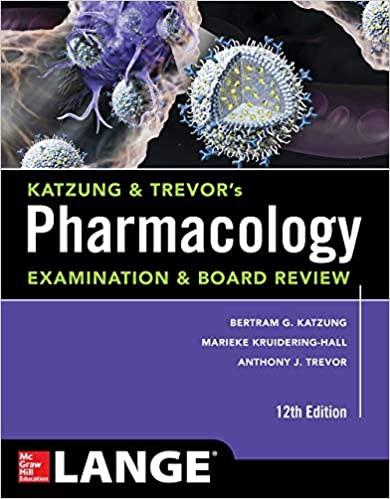Pharmacology Examination and Board Review has long been a medical student favorite—and for good reason. The book provides a clear and concise review of the basic science of pharmacology, presented with a clinical flavor.
The main strength of this book is its overall level of organization and attention to relevant basic science details. Whenever possible, drugs are classified on the basis of their clinical use in specific clinical conditions (e.g., “Drugs used in heart failure” or “Drugs used in hypertension”). The more difficult-to-classify drugs are discussed in terms of molecular or end-organ effects (e.g., “Sympathomimetics” or “Adrenoreceptor blockers”). The pharmacology discussions are well integrated with important concepts in physiology, molecular biology and histopathology. This makes Pharmacology Examination and Board Review (2018) the best review book for helping learners understand how various drugs exert their pharmacologic effects on cells, tissues and organ systems.

Unfortunately, the book lacks the nuance that clinical practitioners would appreciate and continues to recommend useless and obsolete treatments. For example:
- The book claims (page 417) that amantadine and rimantadine “are prophylactic against influenza A.” This appears to be incorrect. The CDC, whose website I accessed on 3/14/2020, says that these drugs “are not recommended for use in the United States at this time because of widespread antiviral resistance in circulating influenza A viruses.” Similarly, the Infectious Diseases Society of America says that “Clinicians should use … oral oseltamivir or inhaled zanamivir … if preexposure chemoprophylaxis for influenza is administered rather than an adamantane antivirals [i.e., amantadine and rimantadine].”
- The book asserts (page 116) that “digitalis is the traditional positive inotropic agent used in the treatment of chronic heart failure,” although it is “no longer considered [among] first-line drugs in the treatment of heart failure” (page 114). This is way too generous. According to UpToDate accessed on 3/14/2020, “because much of the controlled data on digoxin preceded the widespread use of contemporary guideline-directed therapies, it is unclear whether and to what extent the observed benefits of digoxin apply to patients receiving optimal guideline-directed therapy.” Furthermore, “Patients assigned to digoxin therapy had a nominally lower mortality rate from worsening HF that did not reach statistical significance (11.6 versus 13.2 percent for placebo, p = 0.06); this nominal benefit was counterbalanced by a significant increase in non-HF cardiac deaths, which included death from arrhythmia (15 versus 13 percent).” More, in UpToDate.
- The book says that “glucosamine is primarily used for pain associated with osteoarthritis” (page 51) and that “the formulation of glucosamine plays an important role with regard to efficacy” (id.). However, the 2019 Osteoarthritis Research Society International (OARSI) guidelines for the non-surgical management of knee, hip, and polyarticular osteoarthritis doesn’t even dignify glucosamine with a mention, let alone a discussion. (The 2014 iteration was a bit more explicit: glucosamine is “not appropriate” for disease modification and is of “uncertain benefit” for symptom relief).
Because of these limitations, I recommend Pharmacology Examination and Board Review (2018) primarily to early-year medical students who are trying to understand the basic structure and thought process of pharmacology. Unfortunately, as the examples above seem to suggest, the book, in its current form, is insufficient reliable for direct application to clinical practice. To correct this problem, future editions should be heavily reviewed and edited by currently-practicing expert clinicians.


Leave a Reply